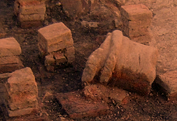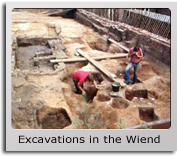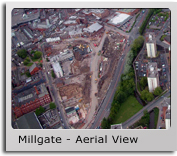
|
 |
||
|
Wigan's Bathhouse Excavations "2005 was a special year for Wigan. Almost over night we saw it go from the lower division to the dizzy heights of the Premiership, and this was not just in the world of the football." These were the words used by Oxford Archaeology North's Ian Miller to describe Wigan's sudden rise to fame in the world of Roman archaeology. Bathhouses are not that common in Britain, but to find one of such good quality and from such an early date in this part of the North West, is quite remarkable, putting Wigan amongst some of the more important sites in the early days of the conquest of the North. |
|||
 |
Roman Wigan It has always been assumed that there was a Roman station at Wigan. Even as early as the beginning of the 19th century the Rev Edmund Sibson suggested it was Coccium, the Roman fort which appears in early Roman literature, and was able to trace three Roman roads leading into Wigan from Warrington, Manchester and Preston. Added to this, many Roman finds have turned up over the years including funerary vessels from the area of the Gas Works, a Roman altar stone in the Parish Church and many coins and potsherds from around the town centre. However, it was only in the early 1980's, with excavations in the Wiend, that the true nature of Wigan's Roman heritage began to emerge. Two seasons of excavations, by a team from Manchester University, revealed for the first time that Wigan was indeed settled by the Romans and was being used for some kind of industrial activity. Evidence of metal-working and military-style wooden buildings from the late 1st to the early 2nd century fitted well with other well known sites in the region such as Wildespool and Walton-le-Dale, but significantly, no indications of a fort. |
||

|
Development Since the advent of planning guidance legislation in the mid 1990's, developers have been obliged to contribute towards archaeological investigations prior to any new development in historically sensitive areas. When planning permission was granted to Modus to develop a large area in the centre of Wigan, it was obvious to our society that a great opportunity would present itself for further discoveries in an area which may well have survived the ravages of Victorian development. Much of the area in question had been covered in the late 19th century by a huge earthen embankment built for the Central Railway Station which was the terminus for the Great Central Railway (Wigan Junction Branch). Even the River Douglas had to be diverted to accommodate the bank and the viaduct which took the railway over the Douglas Valley eastwards towards Manchester. The area is also very close to the earlier discoveries in the Wiend. A desk-top survey arranged by Greater Manchester Archaeology Unit, was followed by field evaluation work carried out by Oxford Archaeology North (who are based in Lancaster). Our suspicions were soon confirmed when the team began digging in Ship Yard behind the Ship Hotel (latterly called Yates Wine Lodge but more recently, Sam's Bar) in the town centre end of Millgate. Next |
||